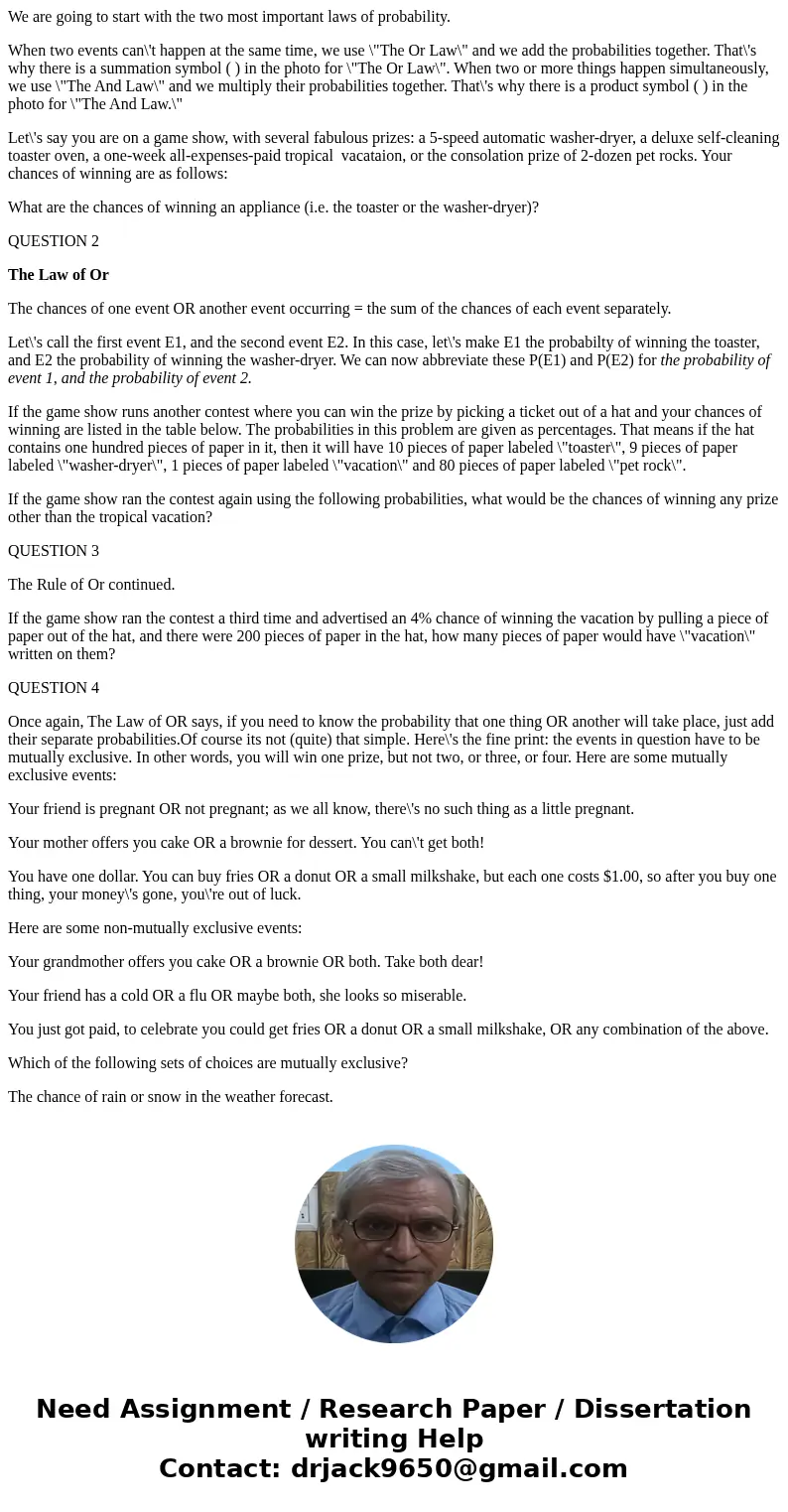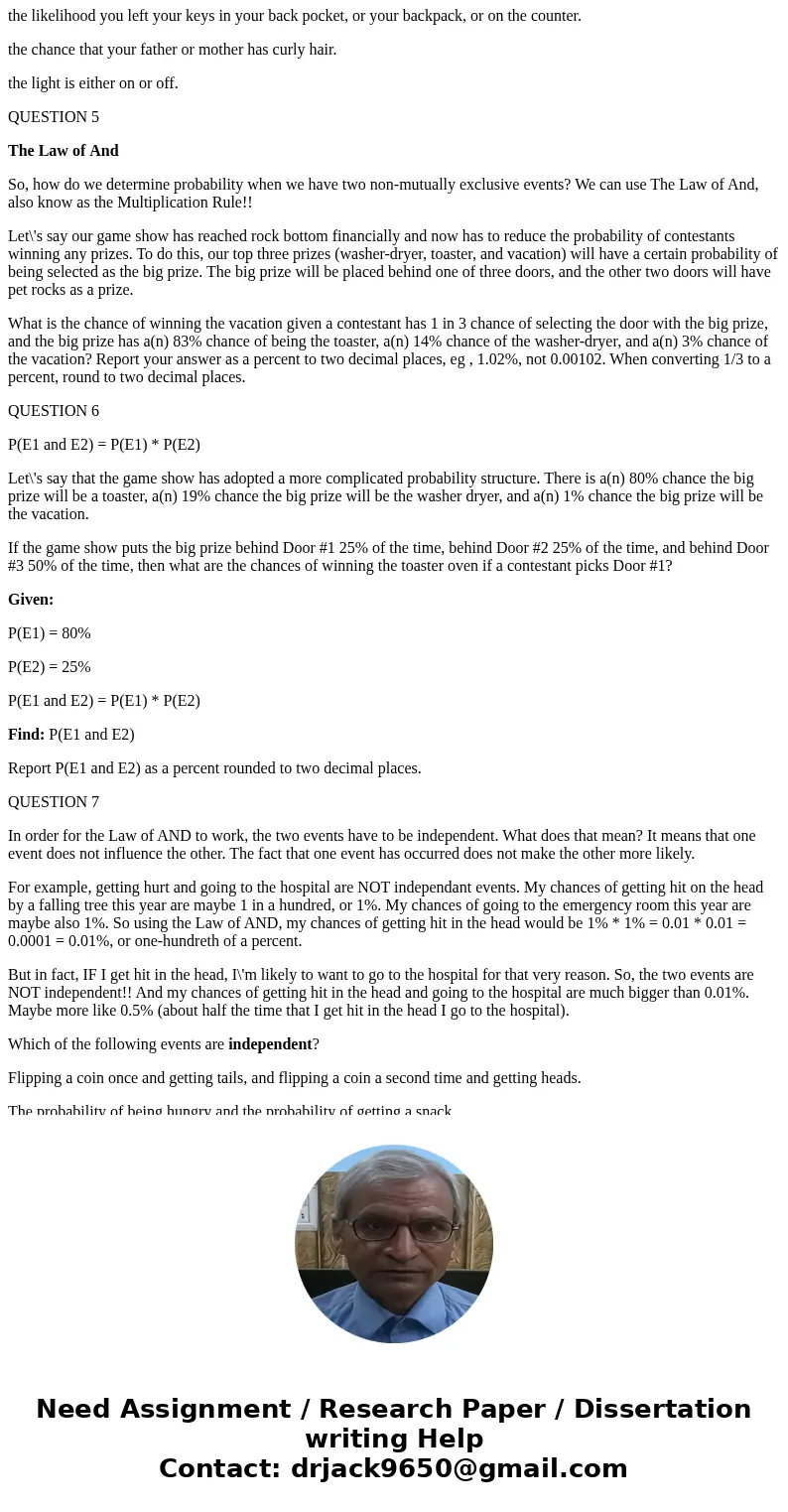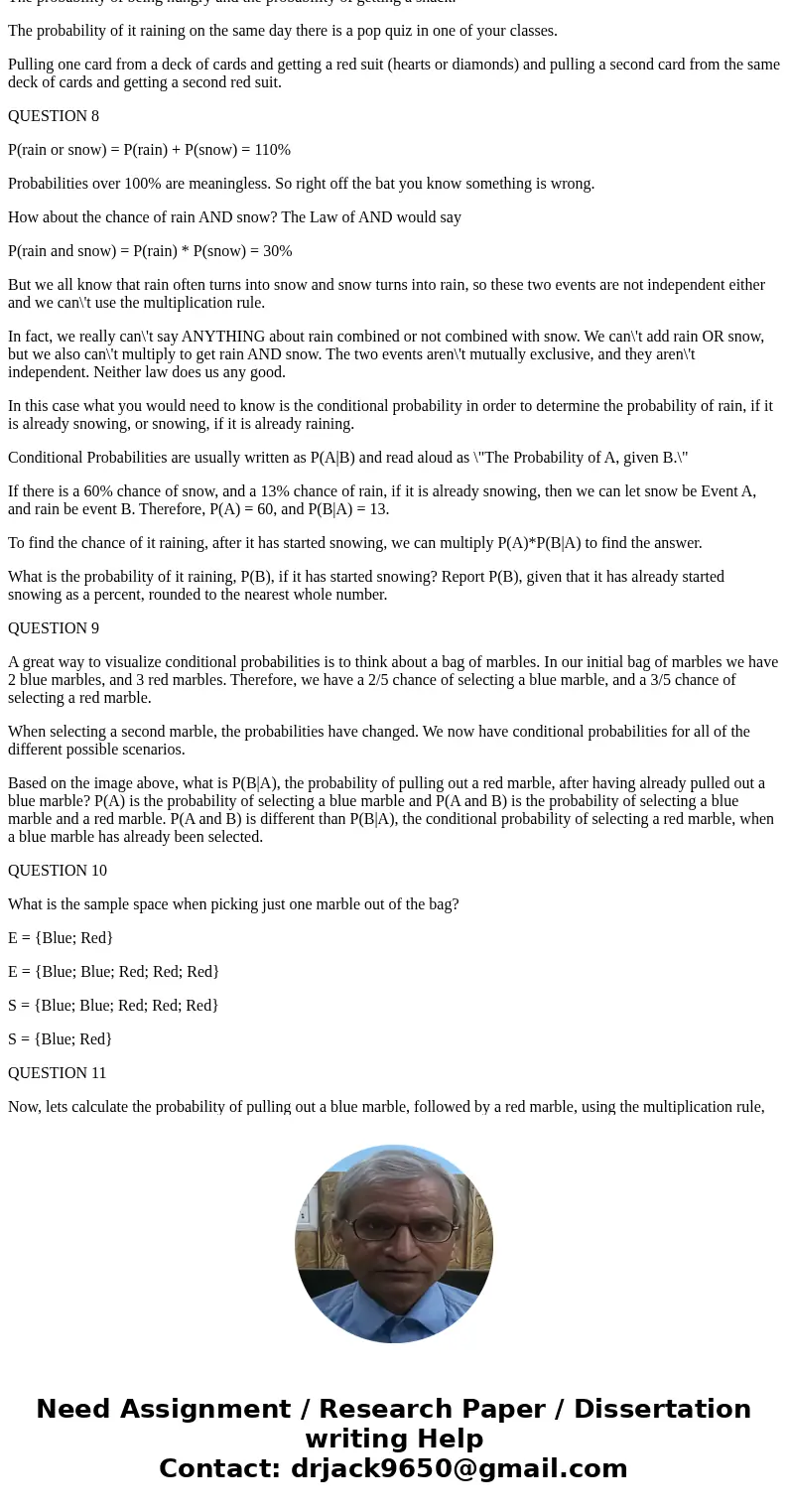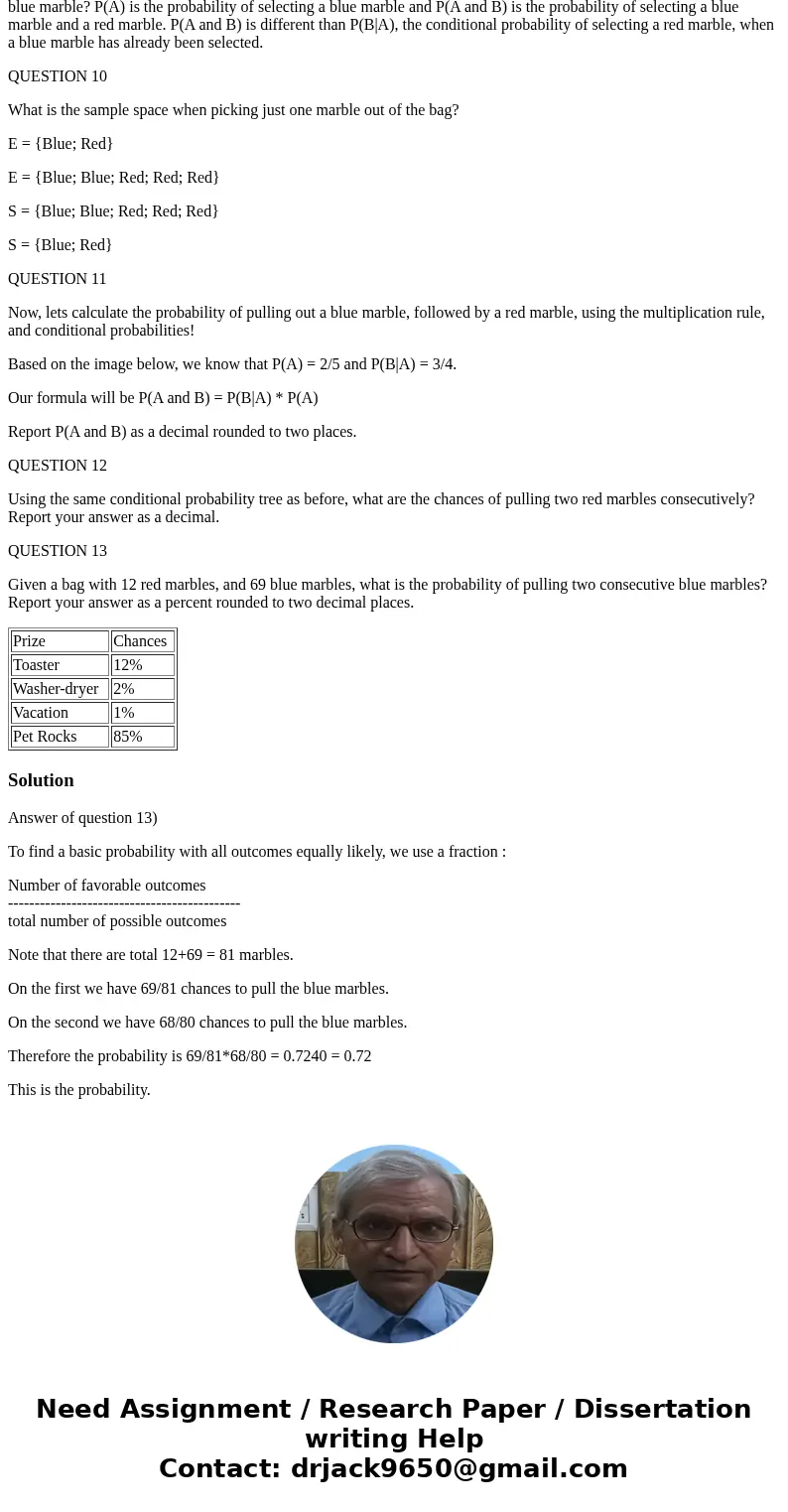We are going to start with the two most important laws of pr
We are going to start with the two most important laws of probability.
When two events can\'t happen at the same time, we use \"The Or Law\" and we add the probabilities together. That\'s why there is a summation symbol ( ) in the photo for \"The Or Law\". When two or more things happen simultaneously, we use \"The And Law\" and we multiply their probabilities together. That\'s why there is a product symbol ( ) in the photo for \"The And Law.\"
Let\'s say you are on a game show, with several fabulous prizes: a 5-speed automatic washer-dryer, a deluxe self-cleaning toaster oven, a one-week all-expenses-paid tropical vacataion, or the consolation prize of 2-dozen pet rocks. Your chances of winning are as follows:
What are the chances of winning an appliance (i.e. the toaster or the washer-dryer)?
QUESTION 2
The Law of Or
The chances of one event OR another event occurring = the sum of the chances of each event separately.
Let\'s call the first event E1, and the second event E2. In this case, let\'s make E1 the probabilty of winning the toaster, and E2 the probability of winning the washer-dryer. We can now abbreviate these P(E1) and P(E2) for the probability of event 1, and the probability of event 2.
If the game show runs another contest where you can win the prize by picking a ticket out of a hat and your chances of winning are listed in the table below. The probabilities in this problem are given as percentages. That means if the hat contains one hundred pieces of paper in it, then it will have 10 pieces of paper labeled \"toaster\", 9 pieces of paper labeled \"washer-dryer\", 1 pieces of paper labeled \"vacation\" and 80 pieces of paper labeled \"pet rock\".
If the game show ran the contest again using the following probabilities, what would be the chances of winning any prize other than the tropical vacation?
QUESTION 3
The Rule of Or continued.
If the game show ran the contest a third time and advertised an 4% chance of winning the vacation by pulling a piece of paper out of the hat, and there were 200 pieces of paper in the hat, how many pieces of paper would have \"vacation\" written on them?
QUESTION 4
Once again, The Law of OR says, if you need to know the probability that one thing OR another will take place, just add their separate probabilities.Of course its not (quite) that simple. Here\'s the fine print: the events in question have to be mutually exclusive. In other words, you will win one prize, but not two, or three, or four. Here are some mutually exclusive events:
Your friend is pregnant OR not pregnant; as we all know, there\'s no such thing as a little pregnant.
Your mother offers you cake OR a brownie for dessert. You can\'t get both!
You have one dollar. You can buy fries OR a donut OR a small milkshake, but each one costs $1.00, so after you buy one thing, your money\'s gone, you\'re out of luck.
Here are some non-mutually exclusive events:
Your grandmother offers you cake OR a brownie OR both. Take both dear!
Your friend has a cold OR a flu OR maybe both, she looks so miserable.
You just got paid, to celebrate you could get fries OR a donut OR a small milkshake, OR any combination of the above.
Which of the following sets of choices are mutually exclusive?
The chance of rain or snow in the weather forecast.
the likelihood you left your keys in your back pocket, or your backpack, or on the counter.
the chance that your father or mother has curly hair.
the light is either on or off.
QUESTION 5
The Law of And
So, how do we determine probability when we have two non-mutually exclusive events? We can use The Law of And, also know as the Multiplication Rule!!
Let\'s say our game show has reached rock bottom financially and now has to reduce the probability of contestants winning any prizes. To do this, our top three prizes (washer-dryer, toaster, and vacation) will have a certain probability of being selected as the big prize. The big prize will be placed behind one of three doors, and the other two doors will have pet rocks as a prize.
What is the chance of winning the vacation given a contestant has 1 in 3 chance of selecting the door with the big prize, and the big prize has a(n) 83% chance of being the toaster, a(n) 14% chance of the washer-dryer, and a(n) 3% chance of the vacation? Report your answer as a percent to two decimal places, eg , 1.02%, not 0.00102. When converting 1/3 to a percent, round to two decimal places.
QUESTION 6
P(E1 and E2) = P(E1) * P(E2)
Let\'s say that the game show has adopted a more complicated probability structure. There is a(n) 80% chance the big prize will be a toaster, a(n) 19% chance the big prize will be the washer dryer, and a(n) 1% chance the big prize will be the vacation.
If the game show puts the big prize behind Door #1 25% of the time, behind Door #2 25% of the time, and behind Door #3 50% of the time, then what are the chances of winning the toaster oven if a contestant picks Door #1?
Given:
P(E1) = 80%
P(E2) = 25%
P(E1 and E2) = P(E1) * P(E2)
Find: P(E1 and E2)
Report P(E1 and E2) as a percent rounded to two decimal places.
QUESTION 7
In order for the Law of AND to work, the two events have to be independent. What does that mean? It means that one event does not influence the other. The fact that one event has occurred does not make the other more likely.
For example, getting hurt and going to the hospital are NOT independant events. My chances of getting hit on the head by a falling tree this year are maybe 1 in a hundred, or 1%. My chances of going to the emergency room this year are maybe also 1%. So using the Law of AND, my chances of getting hit in the head would be 1% * 1% = 0.01 * 0.01 = 0.0001 = 0.01%, or one-hundreth of a percent.
But in fact, IF I get hit in the head, I\'m likely to want to go to the hospital for that very reason. So, the two events are NOT independent!! And my chances of getting hit in the head and going to the hospital are much bigger than 0.01%. Maybe more like 0.5% (about half the time that I get hit in the head I go to the hospital).
Which of the following events are independent?
Flipping a coin once and getting tails, and flipping a coin a second time and getting heads.
The probability of being hungry and the probability of getting a snack.
The probability of it raining on the same day there is a pop quiz in one of your classes.
Pulling one card from a deck of cards and getting a red suit (hearts or diamonds) and pulling a second card from the same deck of cards and getting a second red suit.
QUESTION 8
P(rain or snow) = P(rain) + P(snow) = 110%
Probabilities over 100% are meaningless. So right off the bat you know something is wrong.
How about the chance of rain AND snow? The Law of AND would say
P(rain and snow) = P(rain) * P(snow) = 30%
But we all know that rain often turns into snow and snow turns into rain, so these two events are not independent either and we can\'t use the multiplication rule.
In fact, we really can\'t say ANYTHING about rain combined or not combined with snow. We can\'t add rain OR snow, but we also can\'t multiply to get rain AND snow. The two events aren\'t mutually exclusive, and they aren\'t independent. Neither law does us any good.
In this case what you would need to know is the conditional probability in order to determine the probability of rain, if it is already snowing, or snowing, if it is already raining.
Conditional Probabilities are usually written as P(A|B) and read aloud as \"The Probability of A, given B.\"
If there is a 60% chance of snow, and a 13% chance of rain, if it is already snowing, then we can let snow be Event A, and rain be event B. Therefore, P(A) = 60, and P(B|A) = 13.
To find the chance of it raining, after it has started snowing, we can multiply P(A)*P(B|A) to find the answer.
What is the probability of it raining, P(B), if it has started snowing? Report P(B), given that it has already started snowing as a percent, rounded to the nearest whole number.
QUESTION 9
A great way to visualize conditional probabilities is to think about a bag of marbles. In our initial bag of marbles we have 2 blue marbles, and 3 red marbles. Therefore, we have a 2/5 chance of selecting a blue marble, and a 3/5 chance of selecting a red marble.
When selecting a second marble, the probabilities have changed. We now have conditional probabilities for all of the different possible scenarios.
Based on the image above, what is P(B|A), the probability of pulling out a red marble, after having already pulled out a blue marble? P(A) is the probability of selecting a blue marble and P(A and B) is the probability of selecting a blue marble and a red marble. P(A and B) is different than P(B|A), the conditional probability of selecting a red marble, when a blue marble has already been selected.
QUESTION 10
What is the sample space when picking just one marble out of the bag?
E = {Blue; Red}
E = {Blue; Blue; Red; Red; Red}
S = {Blue; Blue; Red; Red; Red}
S = {Blue; Red}
QUESTION 11
Now, lets calculate the probability of pulling out a blue marble, followed by a red marble, using the multiplication rule, and conditional probabilities!
Based on the image below, we know that P(A) = 2/5 and P(B|A) = 3/4.
Our formula will be P(A and B) = P(B|A) * P(A)
Report P(A and B) as a decimal rounded to two places.
QUESTION 12
Using the same conditional probability tree as before, what are the chances of pulling two red marbles consecutively? Report your answer as a decimal.
QUESTION 13
Given a bag with 12 red marbles, and 69 blue marbles, what is the probability of pulling two consecutive blue marbles? Report your answer as a percent rounded to two decimal places.
| Prize | Chances |
| Toaster | 12% |
| Washer-dryer | 2% |
| Vacation | 1% |
| Pet Rocks | 85% |
Solution
Answer of question 13)
To find a basic probability with all outcomes equally likely, we use a fraction :
Number of favorable outcomes
--------------------------------------------
total number of possible outcomes
Note that there are total 12+69 = 81 marbles.
On the first we have 69/81 chances to pull the blue marbles.
On the second we have 68/80 chances to pull the blue marbles.
Therefore the probability is 69/81*68/80 = 0.7240 = 0.72
This is the probability.




 Homework Sourse
Homework Sourse